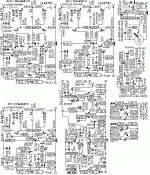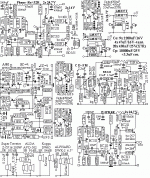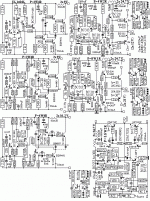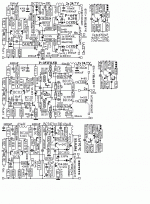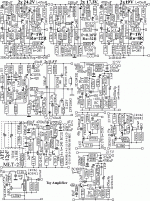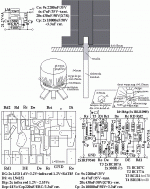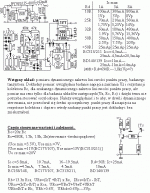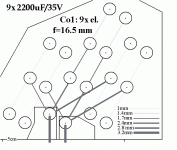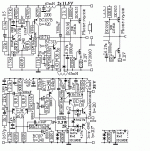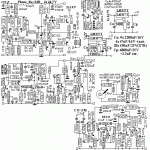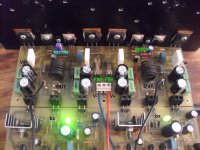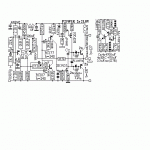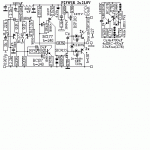DIY quality, custom design-patterns of audio amplifiers.
All amplifiers are low-load resistance,for the use of multiple
speakers, and it is only normal technique.
Information is Compline, together with professional precision
application of power.
The information is varied and good for the school boards.
All amplifiers are low-load resistance,for the use of multiple
speakers, and it is only normal technique.
Information is Compline, together with professional precision
application of power.
The information is varied and good for the school boards.
Attachments
At least.......not to mention the advances in semiconductor technology in the last couple decades. My next amp will be made using 'E-pad' matched mosfets from ALD and planer stripe DMOS devices as the output stage. Its a bit of an experiment and if it works, coupled with everything else in the circuit, should be quite extraordinary.
Its a bit of an experiment and if it works, coupled with everything else in the circuit, should be quite extraordinary.
At least.......not to mention the advances in semiconductor technology in the last couple decades. My next amp will be made using 'E-pad' matched mosfets from ALD and planer stripe DMOS devices as the output stage.Its a bit of an experiment and if it works, coupled with everything else in the circuit, should be quite extraordinary.
I really wasn't being critical to mac, I "port" the better ideas from 30 year old designs (mostly 20 YO Japanese designs), all the time. When you do this with modern semi's , you get "200%" !!! Twice the speed , half the size ... and that is just with through - hole components. I want to play with SMD , but most DIY'ers don't ... I just drilled several hundred holes and boy am I tired !
OS
For some people, these are my old patterns. Interesting because
oldest audio transistors were the best, like people are healthier, but
what concerns people who have been somehow damage. There is
an old-new audio amplifiers are made from using a number of current
sources, which only gives you a cheap and a certain quality but not
the best and most are controlled power transistors, because
otherwise they can not as I gave.
This is my information is good and simple amplifiers and good for
e-schools and these amps are quite modern useless, because they
need the space cooling coils speakers, and this can not be denied.
oldest audio transistors were the best, like people are healthier, but
what concerns people who have been somehow damage. There is
an old-new audio amplifiers are made from using a number of current
sources, which only gives you a cheap and a certain quality but not
the best and most are controlled power transistors, because
otherwise they can not as I gave.
This is my information is good and simple amplifiers and good for
e-schools and these amps are quite modern useless, because they
need the space cooling coils speakers, and this can not be denied.
I really wasn't being critical to mac, I "port" the better ideas from 30 year old designs (mostly 20 YO Japanese designs), all the time. When you do this with modern semi's , you get "200%" !!! Twice the speed , half the size ... and that is just with through - hole components. I want to play with SMD , but most DIY'ers don't ... I just drilled several hundred holes and boy am I tired !
OS
The problem with the very small SMD parts is making the PCB tracks that are so fine. SOT-923 is pretty damn small.
 Also if you use a cad program with these tiny SMDs you want to make at least 2 layers, which can be difficult to create the plated holes or vias. A board house can create this for proto-types easily. The last one I made cost about $150 for 6 PCBs, not too bad. Production runs can get you ~30 PCBs for the same price.
Also if you use a cad program with these tiny SMDs you want to make at least 2 layers, which can be difficult to create the plated holes or vias. A board house can create this for proto-types easily. The last one I made cost about $150 for 6 PCBs, not too bad. Production runs can get you ~30 PCBs for the same price. One of the best improvements to power BJTs was the RET or ring emitter transistor, replacing the old epitaxial types used in audio before. Then came circuit ideas such as local error correction schemes, to correct the non-linearities of Darlington power transistors. Then came the invention of cheap available mosfets. When coupled with proper error correction these devices will outperform BJTs in just about every output stage application hands down, IMO. There have been major advances in small signal components too. Smaller companies such as Advanced Linear Devices or THAT Corp make specialized components. These didn't exist 30+ years ago. The new wave of SMD packages allow for smaller, tighter PCB design. It is true though that most DIYers don't like SMDs.
The last one I made cost about $150 for 6 PCBs, not too bad. Production runs can get you ~30 PCBs for the same price.
I just got an e-mail quote from E-TekNet. For 4 PCBs, 2 layer at 21.89 each. Maximum board size 35 square inches for 2-layer board. Less than 10" in either X or Y direction. 0.062" thick board (FR4 material), 1 oz copper, minimum conductor width/ space >= 7 mil, , minimum annular ring >= 7 mil, minimum hole size >=12 mil (plated through). Non plated through holes are allowed. Board size>1"x1". Tin-lead HAL reflow and green LPI, white silkscreen for both top and bottom sides. For promotions, the boards should have no countersinks, no cutouts and no panels and V-scores. If your specifications are different, please go to PCB Quote Online for our 100% low price guaranteed quote.
Since the quality is very good (this is the company that made the last PCBs for me) for that price it is worth not having to drill 100+ holes per PCB.
If I had a commercial laminator for 100-200$ , "fab in a box" with the thermo- reactive foils for both the tracks and screen sides , I could be my own fab house. With just the primitive Iron and plain toner transfer , myself and MJL (member) seem to get 1-2 mil resolution with no or few pits. The silkscreen is harder , it needs to be white and more durable - thats where the foil/laminator comes in. So for $200-300 , I could become the "factory".
I plan on this ASAP , I'm just a little short of $$. just 2-3 visits to someone elses fab house and I could do it myself with comparable quality.
PS- if I had that stuff , I would do your 6 boards for $60 !!! with at least 95% quality.
OS
I plan on this ASAP , I'm just a little short of $$. just 2-3 visits to someone elses fab house and I could do it myself with comparable quality.
PS- if I had that stuff , I would do your 6 boards for $60 !!! with at least 95% quality.
OS
Last edited:
If I had a commercial laminator for 100-200$ , "fab in a box" with the thermo- reactive foils for both the tracks and screen sides , I could be my own fab house. With just the primitive Iron and plain toner transfer , myself and MJL (member) seem to get 1-2 mil resolution with no or few pits. The silkscreen is harder , it needs to be white and more durable - thats where the foil/laminator comes in. So for $200-300 , I could become the "factory".
I plan on this ASAP , I'm just a little short of $$. just 2-3 visits to someone elses fab house and I could do it myself with comparable quality.
PS- if I had that stuff , I would do your 6 boards for $60 !!! with at least 95% quality.
OS
Wow! That would be a swell set up. With that kind of gig, you could actually make some money to pay for your expensive hobby.
Can someone please explain to me: 95% quality!
Will you give your customer the money back for the wasted parts and time (assembly and troubleshooting, 100 or more times the value of the boards)?
Even good board houses screw up. What they do after is what makes them great (or not)!
E
Will you give your customer the money back for the wasted parts and time (assembly and troubleshooting, 100 or more times the value of the boards)?
Even good board houses screw up. What they do after is what makes them great (or not)!
E
Can someone please explain to me: 95% quality!
Will you give your customer the money back for the wasted parts and time (assembly and troubleshooting, 100 or more times the value of the boards)?
Even good board houses screw up. What they do after is what makes them great (or not)!
E
Hopefully the customer would have done his R and D. If what he submitted was accurately reproduced, the assembly and troubleshooting would be his responsibility , as he was responsible for the design initially.
A gerber is a gerber , there can be no error on the physical artwork. The design is another story. Don't submit a design , just completed artwork.
95% quality refers to tinning vs. soldermask ... or no plated through holes. For DIY this is quite sufficient. double sided is also sufficient for DIY. I get away with single sided for most amps. I just sold 2 sets of below (blank , drilled , and perfect) for $30USD a set.
OS
Attachments
Last edited:
- Status
- This old topic is closed. If you want to reopen this topic, contact a moderator using the "Report Post" button.
- Home
- Amplifiers
- Solid State
- DIY quality, custom design-patterns of audio amplifiers
